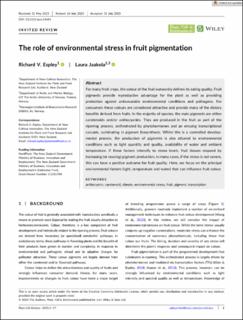| dc.contributor.author | Espley, Richard V. | |
| dc.contributor.author | Jaakola, Laura | |
| dc.date.accessioned | 2023-10-04T12:48:23Z | |
| dc.date.available | 2023-10-04T12:48:23Z | |
| dc.date.created | 2023-09-13T13:33:36Z | |
| dc.date.issued | 2023-08-09 | |
| dc.identifier.citation | Espley, R. V., & Jaakola, L. (2023). The role of environmental stress in fruit pigmentation. Plant, Cell & Environment. Portico. | en_US |
| dc.identifier.issn | 0140-7791 | |
| dc.identifier.uri | https://hdl.handle.net/11250/3094165 | |
| dc.description.abstract | For many fruit crops, the colour of the fruit outwardly defines its eating quality. Fruit pigments provide reproductive advantage for the plant as well as providing protection against unfavourable environmental conditions and pathogens. For consumers these colours are considered attractive and provide many of the dietary benefits derived from fruits. In the majority of species, the main pigments are either carotenoids and/or anthocyanins. They are produced in the fruit as part of the ripening process, orchestrated by phytohormones and an ensuing transcriptional cascade, culminating in pigment biosynthesis. Whilst this is a controlled developmental process, the production of pigments is also attuned to environmental conditions such as light quantity and quality, availability of water and ambient temperature. If these factors intensify to stress levels, fruit tissues respond by increasing (or ceasing) pigment production. In many cases, if the stress is not severe, this can have a positive outcome for fruit quality. Here, we focus on the principal environmental factors (light, temperature and water) that can influence fruit colour. | en_US |
| dc.language.iso | eng | en_US |
| dc.publisher | John Wiley & Sons Ltd. | en_US |
| dc.rights | Navngivelse 4.0 Internasjonal | * |
| dc.rights.uri | http://creativecommons.org/licenses/by/4.0/deed.no | * |
| dc.title | The role of environmental stress in fruit pigmentation | en_US |
| dc.title.alternative | The role of environmental stress in fruit pigmentation | en_US |
| dc.type | Peer reviewed | en_US |
| dc.type | Journal article | en_US |
| dc.description.version | publishedVersion | en_US |
| dc.rights.holder | © 2023 The Authors | en_US |
| dc.source.journal | Plant, Cell and Environment | en_US |
| dc.identifier.doi | 10.1111/pce.14684 | |
| dc.identifier.cristin | 2174726 | |
| dc.relation.project | Nordforsk: 84597 | en_US |
| cristin.ispublished | true | |
| cristin.fulltext | original | |
| cristin.qualitycode | 2 | |

